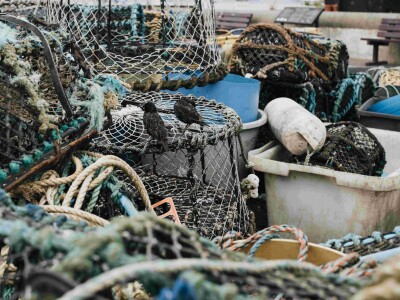Five feet high and rising
From U.S. Coast Guard reports
One cool late-May day about 130 nautical miles southeast of Nantucket, the skipper and two crew members of a steel dragger had just begun their first set of a four-day whiting trip. Once the trawl was set, the captain let the crew go below deck to rest.
At about 4:30 p.m. the skipper decided to check the main engine, which he could feel and hear misfiring. Thinking clogged or dirty fuel filters were to blame, he placed the boat on autopilot and went to rectify the problem. On the way, he woke his crew in preparation of hauling back.
When he reached the engine room, he was alarmed to find the water level above the floorboards and rising. The skipper quickly engaged all of the bilge-dewatering pumps to fight the flooding. Since the bilge alarm hadn't alerted the crewmen of the problem, the skipper hurried topside to notify them.
About half an hour later, the flooding shut down the main engine. The vessel's generator, however, kept providing power to the dewatering equipment.
The crew couldn't determine the source of the flooding. With the engine room water level still rising, the skipper ordered the crew to ready the life raft and put on immersion suits.
At 5:30 p.m., the generator shut down. Emergency back-up power allowed the skipper to transmit a mayday call. Another vessel fishing nearby answered the call and relayed the information to the U.S. Coast Guard.
Realizing their vessel would soon sink, the three men mustered on deck, donned their immersion suits, and deployed the inflatable life raft. Before entering the raft, one crew member grabbed the vessel's handheld VHF radio, as practiced during emergency drills. When all were aboard, the skipper cut the sea painter that connected the raft to the boat.
At approximately 6:30 p.m. a Coast Guard Falcon jet arrived and established radio communications with the crew. An hour later, a U.S. Coast Guard rescue helicopter arrived and hoisted them to safety. The boat sank in 800 feet of water.
Lessons learned
Progressive flooding is a constant threat at sea. It's good practice to have at least two power-driven bilge pumps installed with separate power supplies in case of emergency. Keep bilge pumps and piping systems in good working order; frequently inspect suction screens and clear them of obstructions.
Install water-level sending units in the bilge area, shaft alley, and lazarette to activate alarms, should flooding occur. Check high-water alarms to ensure they are working before each trip.
A working bilge alarm could have alerted the crew earlier, giving them more time to find the leak and possibly control the flooding.
The crew's quick response, knowledge of emergency procedures, and familiarity with safety equipment enabled them to come home safe. All three men attributed their survival to participating in Coast Guard safety and survival workshops offered by the Northeast's Commercial Fishing Vessel Safety Program.
These programs help fishermen gain confidence and proficiency in using survival gear and handling emergencies through practical demonstrations. To find out when and where these programs are offered, visit www.fishsafe.info/locateexaminers.htm. Fish safe!
This article is based on U.S. Coast Guard reporting and is intended to bring safety issues to the attention of our readers. It is not intended to judge or reach conclusions regarding the ability or capacity of any person, living or dead, or any boat or piece of equipment.






